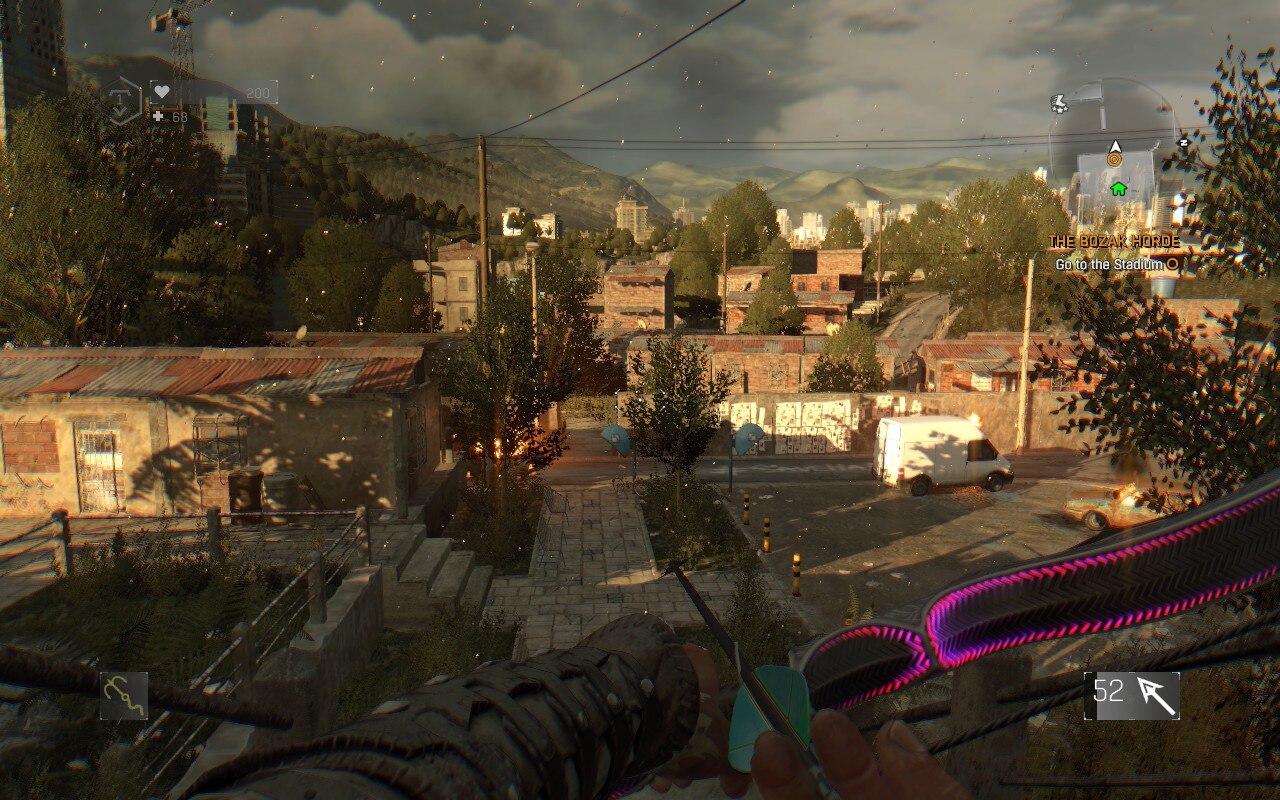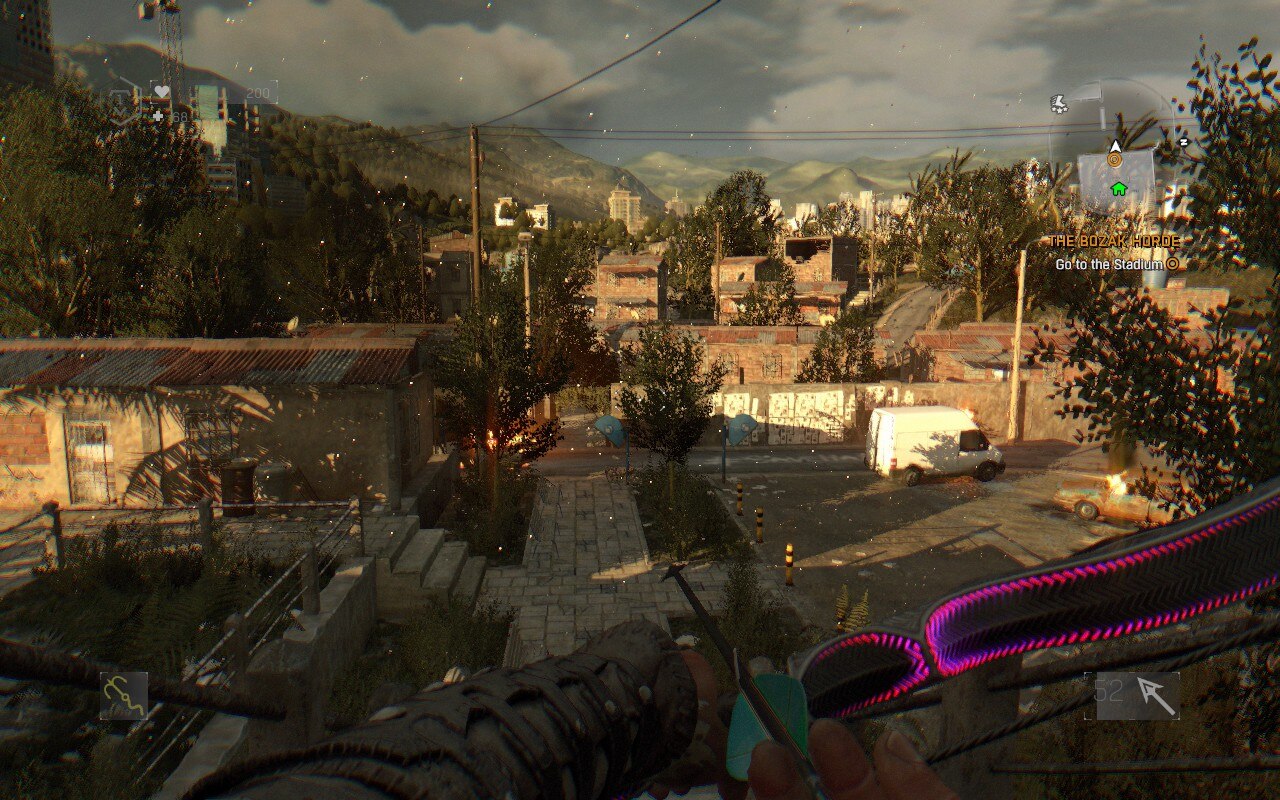Performance Overview
Dying Light is an extremely complex game. Tons of on-screen enemies wailing their limbs, explosions, a day/night cycle, and an excellent parkour system are just some of the elements that make this game such a delight to play.
But how does it handle on the Steam Deck? Despite the myriad complexities, Dying Light runs exceptionally well on the Steam Deck. I’m just as shocked as you are!
With my settings listed below, I was able to get a steady 50 to 60 frames per second, with the occasional dips into the 40s when things get a little chaotic. Chances are, you won’t feel the majority of the drops. The Steam Deck, combined with some very talented developers, somehow manages to keep the action feeling fluid and snappy.


Left: Dying Light on custom settings. Right: Dying Light running on high settings.
Visually, Dying Light on Steam Deck stuns. It is possible to play with all the settings cranked up to the max, but expect somewhere in the realm of the high-20s. I averaged around 29 frames per second when things were quiet with everything maxed out.
To be honest, although you do lose some distance quality, playing with the settings turned down and at 60 frames per second is the best way to play. It’s mostly playable at 30, but the extra frames at 60 really help to keep things feeling fluid.
Recommend Settings
The settings below sacrifice some visual fidelity in favor of a much smoother experience. When you compare the custom and high visuals next to one another, sure, there’s a difference. But that doesn’t mean turning some settings to medium is going to result in an ugly game. Dying Light still looks great even with these settings.
Personally, I found the game more enjoyable at a smooth-ish 60. When you’re bouncing off a car and grappling onto a roof before dropkicking a zombie, there’s a lot going on at any given time, and the extra frames help to keep the action moving without any choppiness.
| Dying Light (In-game Settings) | |
| Resolution |
1280×800 (16:10) |
| Borderless Window | Off |
| Veritcal Synchronization | On |
| Frame Rate Cap | Veritcal Synchronization |
| Texture Quality | Medium |
| Shadow Map Size | Medium |
| Foliage Quality | Medium |
| View Distance | Far Left |
| Ambient Occlusion | Off |
| Nvidia HBAO+ | Off |
| Nvidia Depth of Field | Off |
| Nvidia PCSS | Off |
| Motion Blur | Off |
| Antialisaing | On |
| Film Grain Effect | Off |
| Chromatic Abberation Effect | On |
| Steam Deck Settings (Quick Access Menu) | |
| TDP: 10 (50-60 frames) | Estimated Battery Life: 2 Hours |
| Docked Mode Resolution: 1280×720 | FSR: On (Docked Mode) |
| GPU Usage: 98% | Temperature: 67 degrees |
| Extra Info | |
| Fills the Entire Steam Deck Screen | Yes |
| Valve Grading | Verified |
| Performance Rating: 4/5 | |
Issues
Obviously, with a game with this many moving parts there are going to be minor bugs and potential crashes. That’s just the nature of the beast. That said, I haven’t come across anything that particularly kills the experience. Popping heads and loosing arrows feels and handles brilliantly on the Steam Deck.
The antialiasing is constantly in a battle to contain jagged, distant edges, but it’s older tech now, so it’s forgivable and manageable. Plus it’s less noticeable in handheld mode, which I assume is how most Steam Deck owners will play.
Conclusion
Dying Light remains one of the best zombie games out there. The story keeps things moving and the gameplay is a symphony of chaos. When you’re vaulting across rooftops trying to avoid getting ripped apart, that’s when Dying Light truly enters a place no other game goes.
On Steam Deck, Dying Light is a joy to play, and thanks to the larger screen, there’s enough space to read what’s going on without feeling overwhelmed.
If you’ve yet to play this game, or you’re on your 700th playthrough, Dying Light on Steam Deck comes very easy to recommend.

Disclosure: Review code purchased online. | All screenshots captured on Steam Deck.| To learn more about our review policy click here. | Alternatively, click here to find out why you can trust me.

